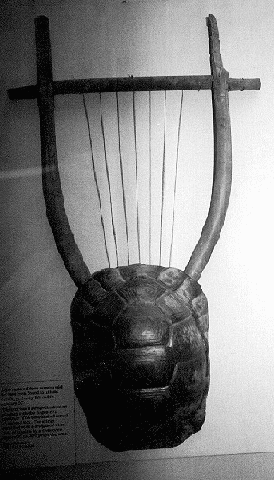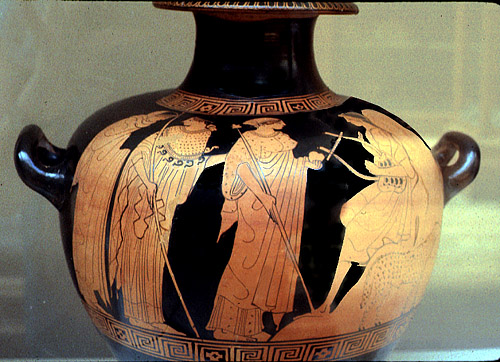Now, I'm sure that most anyone interested in an instrument like the lyre has a general idea of how stringed instruments work, but just in case, let's dissect this baby.
Because there is no variation in distance between the bridge and (for lack of a better word) the yoke, the strings are all the same length on a Greek lyre. Perhaps you'll see what I mean when you compare the above depiction of the twin Greek lyres with this picture of an Iraqi lyre. See how the yoke is far from perpendicular to the crossbars?
There are two methods of attaining pitch on a stringed instrument (providing all strings are the same material) - the length of the string, and the tension on the string. Because all of the strings on Greek lyres were the same length, (in contrast with the aforementioned Iraqi lyre and most modern lyres), any pitch difference had to be attained by string tension. Essentially, the tighter the string is, the less the string will allow for vibration, and the tighter that vibration will be. Quite cleverly, most of my sources believe that the strings, after being affixed to a tuning peg, were wrapped with a wet, sticky hide (from the necks of oxen and sheep), making the strings much easier to tune, as they only required a slight rotation (again, straining the tension on the strings a bit more).
I'd be willing to bet that no musician could go two consecutive songs without another tuning; even modern strings go out of tune frequently, and animal matter has a tendency to stretch quite a bit! One has to wonder how long lyres lasted if the catgut was consistently being more and more embedded into the yoke. Perhaps the strings were replaceable, if the musician was fully prepared to deal with the sticky mess of unraveling the fat-laced tuners.
According to the Encyclopaedia Britannica (Arts, Sciences, and General Literature), there is a controversy regarding the number of strings the ancient Greek lyre had. While Diodorus believed that Hermes originally made his lyre with three strings (with ascending pitches), Macrobius thought that Mercury's lyre had 4 ascending strings, one for every season. Lucid and Ovid (bless you, google translator!) say that the original lyre had seven strings, but then we get this fruity little paragraph from Plutarch:
"When Phrynis added two strings to the seven-stringed lyre, the Ephors inquired whether he preferred to let them cut out the two upper or the two lower strings; 1 but in our case it is both the upper and the lower that require lopping off if we are to be brought to the state which is a mean between excess in either direction; and one of the first results of progress is an abatement of the excess and keenness of our emotions,"So are we to assume that there were 9 strings after Phrynis' lyre? And if so, why is it near-impossible to find an ancient depiction of a 9-stringed lyre?
There are scholars who genuinely argue about such things; I see no reason why, for the same reason we have differently-numbered strings on banjos, there were different lyres with a different number of strings. Whether or not there were specific string numbers attributed to specific city states or regions may be something for a future entry.. We'll see how much I can dig up.
Encyclopaedia Britannica,
Arts Sciences and General Literature
Volume 13, Issue 2
Diodorus Siculus: Library of History, Volume II, Books 2.35-4.58, Diodorus (Loeb Classical Library No. 303) (v. 2)
The Heroïdes: or, Epistles of the Heroines. The armours, Art of love, Remedy. Ovid, Ep 3, p. 27
Plutarch. Moralia. with an English Translation by. Frank Cole Babbitt. Cambridge, MA. Harvard University Press. London. William Heinemann Ltd. 1927. 1.
Reconstructing the Greek Tortoise-Shell Lyre
Author(s): Helen Roberts
Source: World Archaeology, Vol. 12, No. 3, Archaeology and Musical Instruments (Feb., 1981),
pp. 306-309












